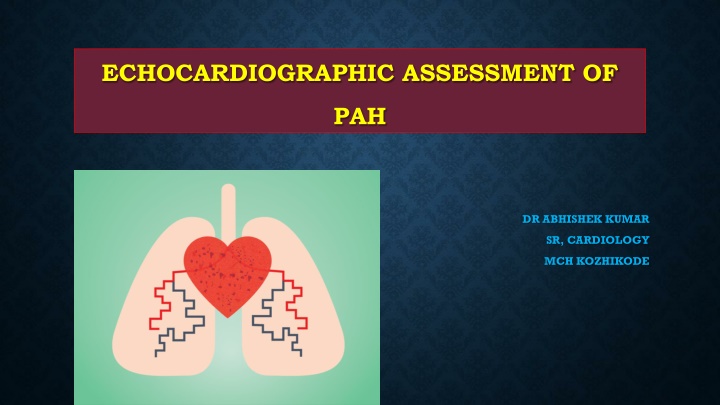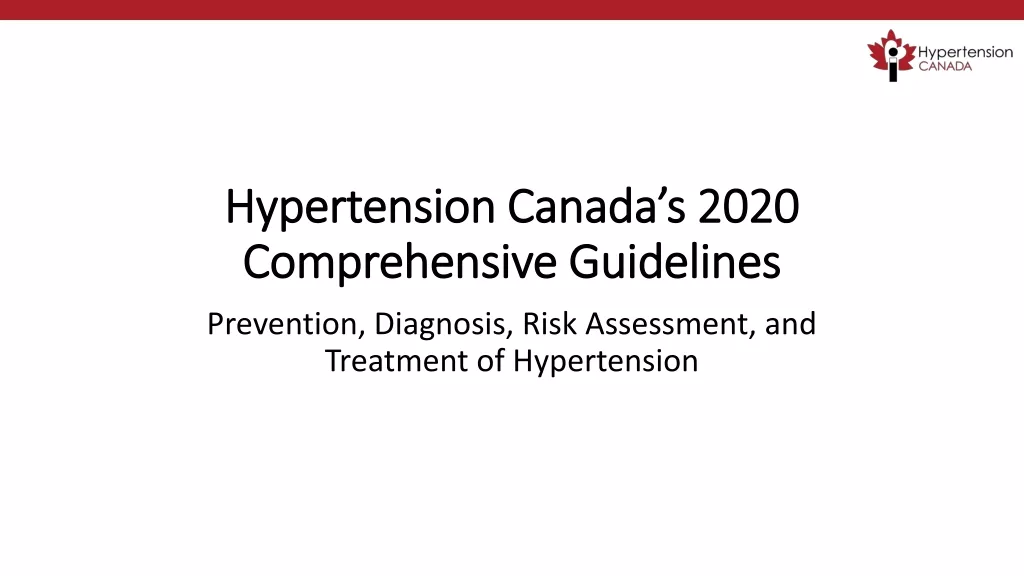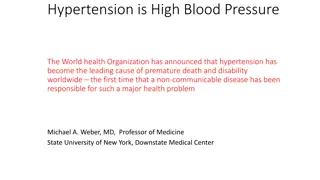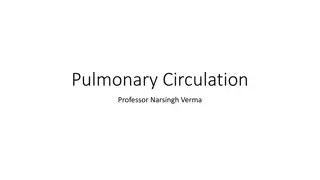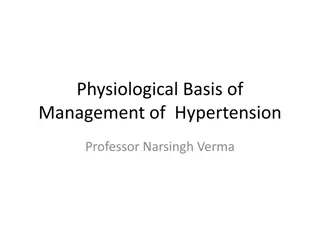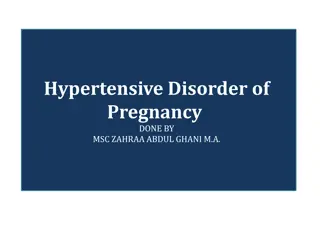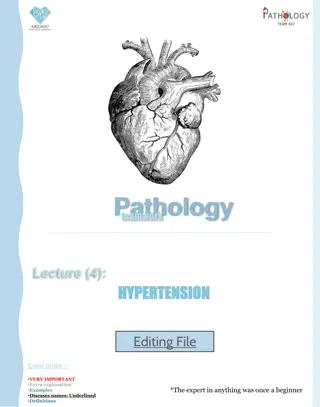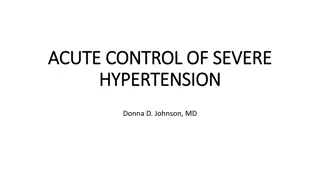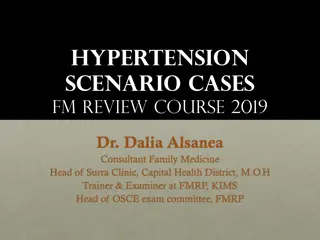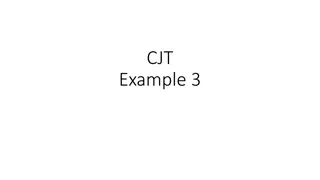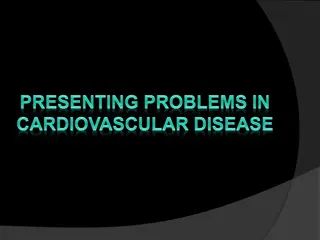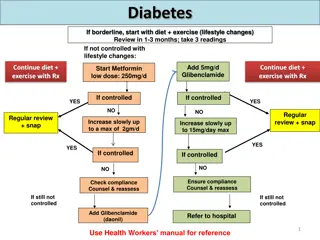Echocardiographic Assessment of Pulmonary Arterial Hypertension (PAH) Overview
Echocardiographic assessment plays a crucial role in the diagnosis, management, and prognostic evaluation of pulmonary arterial hypertension (PAH). This condition is characterized by elevated mean pulmonary arterial pressure and pulmonary vascular resistance, leading to various clinical features such as progressive shortness of breath and cardiac complications. Transthoracic echocardiography provides essential information for assessing right heart hemodynamics, determining PAH severity, and monitoring treatment response. Early detection through echocardiographic screening is vital for timely intervention and risk stratification in PAH patients.
Download Presentation

Please find below an Image/Link to download the presentation.
The content on the website is provided AS IS for your information and personal use only. It may not be sold, licensed, or shared on other websites without obtaining consent from the author.If you encounter any issues during the download, it is possible that the publisher has removed the file from their server.
You are allowed to download the files provided on this website for personal or commercial use, subject to the condition that they are used lawfully. All files are the property of their respective owners.
The content on the website is provided AS IS for your information and personal use only. It may not be sold, licensed, or shared on other websites without obtaining consent from the author.
E N D
Presentation Transcript
ECHOCARDIOGRAPHIC ASSESSMENT OF PAH DR ABHISHEK KUMAR SR, CARDIOLOGY MCH KOZHIKODE
Echocardiographic assessment of PAH - OVERVIEW Definition Classification and Pathophysiology Diagnosis Management Role of Echo in PAH Screening Diagnosis Evaluation of structure, function and hemodynamics of RV and PA Determining the etiology and PH group Risk stratification Treatment response and monitoring Prognostic evaluation
DEFINITION Pulmonary hypertension is a haemodynamic and pathophysiological condition characterised by Mean PAP greater than25mmHgatrestor>30mmHgduringexerciseandpulmonaryvascularresistance >3woodunits. Normalmeanpulmonary arterypressureis14 3mmHg MILD=25 40mmHg MODERATE =41-55mmHg SEVERE>55mmHg PH may be associated with a number of conditions displaying a range of different pathological and clinical features, despitethecomparable elevations inPApressure. RightHeartCatheterization isconsidered tobethe goldstandard forthediagnosisofPH Transthoracic echocardiography provides a number of measures that can be used to estimate right heart haemodynamics andguidelinesrecommend classIindication forscreening anddiagnosisofPH
CLINICAL FEATURES Generally nonspecific. Progressive shortness of breath, which is particularly marked during exercise. Syncopal episodes, presumably related to cardiac arrhythmias Chest pain as a sign of right-sided cardiac ischemia and is seen late in the course in those who develop cor pulmonale Abdominal discomfort as a sign of right-sided heart failure with progressive liver congestion. Features associated with cardiac valvular lesions, predominately on the left side of the heart.
WHEN TO SUSPECT AND SCREEN FOR PAH? Family history 12% prevalence Of positive family history. Related genes - BMPR2, ALI, flagellin, MMP9 etc. Autosomal dominant, incomplete penetrance, genetic anticipation Connective tissue disease Limited and diffuse scleroderma: 8%-30% CREST: up to - 25% Systemic lupus erythematosus: 4% - 14% Rheumatoid arthritis up to 21% Congenital Heart Disease Reversal of left-to-right shunt Ventricular septal defect, patent ductus arteriosus, atrial septal defect, portal hypertension Deep venous thrombosis/history of pulmonary embolism Up to 3-4% of survivors
WHEN TO SUSPECT AND SCREEN FOR PAH? HIV 0.5% (1/200) patients Sickle cell disease Haemodialysis patients Yearly echocardiography is recommended in patients at risk for heritable PAH With CTD, especially patients with scleroderma and SLE Hence echocardiography should be considered, in patients with PH suggestive symptoms After pulmonary embolism With HIV infection With portal hypertension With prior appetite suppressant use With sarcoidosis After splenectomy
WHEN TO SUSPECT AND SCREEN FOR PAH? Limitations of Echocardiography in PAH Experienced technicians and interpreting physicians are essential Consistency of skilled technicians/readers Images can be limited in some patient populations RV, the chamber of highest concern in PAH, is the least emphasized on the "standard echocardiography exam TR jet may be absent in some patients, thus precluding PASP assessment May overestimate or underestimate actual pulmonary arterial pressure
RA ENLARGEMENT 4 chamber view Area trace DILATED RA = WHEN RA AREA > 18 cm2 at end systole POOR PROGNOSTIC SIGNS IN PHT : RA AREA > 26 cm2
ESTIMATION OF PA PRESSURE USING ECHO PA SYSTOLIC PRESSURE In the absence of RVOT obstruction RVSP = SYSTOLIC PAP. RVSP Calculated using the formula (4 x TRV2) + RAP. Central jet - A4C view / RV focused view. Eccentric jet - RV inflow view. Under estimated in RV failure , poor alignment of jet and mild TR. Over estimated in anaemia and with use of agitated saline contrast
ESTIMATION OF PA PRESSURE USING ECHO PA DIASTOLIC PRESSURE : 4xPRVed2+RAP MEAN PAP : 4 x PR Vmax2 + RAP 0.61 x SPAP + 2 mm Hg TR VTI + RAP DEBASTANI MAHAN S equation : 90 0.62 x rvot acc time ( heart rate < 120 msec ) 79 0.45 x rvot acc time ( heart rate > 120 msec )
ESTIMATION OF PA PRESSURE USING ECHO RVOT ACCELERATION TIME Measurement of RVOT acceleration time Parasternal short axis view End expiration PW doppler just proximal to Pulmonary valve Doppler beam aligned with pulmonary forward flow beam Sweep speed of 100 . Normal RVOT AT > 130 msec In PHT RVOT AT < 100 msec
ESTIMATION OF PA PRESSURE USING ECHO TR VTI Tricuspid regurgitation velocity time integral
ESTIMATION OF PA PRESSURE USING ECHO RA PRESSURE RA pressure estimation should not be based upon arbitrary value but rather based upon 2D and doppler study of IVC and hepatic veins Right atrial pressure : (ASE 2020 guidelines) Subcostal view - M mode 0.5 3.0 cm from its opening into RA Just before the junction of hepatic vein into IVC. End expiration
ESTIMATION OF PA PRESSURE USING ECHO RA PRESSURE USING IVC SEVERITY OF PULMONARY HTN BASED ON RVSP
RV IN PAH - MORPHOLOGY First step is obtaining a RV focused image in apical 4 chamber view RV focused view is obtained by angling the medially toward the patient s right shoulder. adjustments in angle and rotation maybe necessary to demonstrate all the structures for this view optimally. sound beam Slight
RV IN PAH - MORPHOLOGY Qualitative assessment of RV size Eyeballing method
RV IN PAH - MORPHOLOGY Quantitative assessment Measurement taken at end diastole from RV focused view in apical 4 chamber view Optimization of image to have maximum diameter without foreshortening RV Enlargement RV D1 > 42 mm or RV D2 > 36 mm RV length > 82 mm RV Area > 28 cm2 RVH RV thickness > 5 mm RV end diastolic diameter has been identified as a predictor of survival in patients with chronic pulmonary disease
LEFT VENTRICLE IN PAH Normally shape of left ventricle is circular both during systole and diastole. Increase in RV pressure causes the flattening of IVS towards LV, which gives a D shape of LV. LV eccentricity index is the ratio of the major axis of the LV parallel to the septum (D2) divided by the minor axis perpendicular to the septum (D1) and is measured in the parasternal short-axis view at the level of the LV papillary muscles in both end diastole and end systole. D shape LV during diastole RV Volume overload D shaped LV during systole RV pressure overload D shape during both combined overload of RV LV diastolic eccentricity index in diastole > 1.7 has been shown to be prognostic of mortality in patients with idiopathic PAH
RV IN PAH - FUNCTION RV function evaluation methods Tricuspid annular plane systolic excursion (TAPSE) Tricuspid annulus TDI velocities (S ) RV MPI (Tei Index) RV area fractional shortening Dp/dt method RV longitudinal strain measurement 3D RV volume assessment 3D strain imaging
RV IN PAH - FUNCTION TAPSE Defined by the total excursion of the tricuspid annulus from its highest position after atrial ascent to the peak descent during ventricular systole In Apical-4 chamber view, place M-Mode cursor through the lateral tricuspid annulus and measure excursion from end-diastole to end- systole averaged over 3 beats Simple, reproducible Represents longitudinal function Correlates well with radionuclide angiography in determining RV systolic function. Relatively load and angle dependent. Normal > 20 mm. TAPSE < 18 mm has negative prognostic implications
RV IN PAH - FUNCTION By TDI, several indices of RV function can be obtained from a single cardiac cycle TV ANNULAR VELOCITY (S') BY TDI Simple, sensitive, reproducible Good indicator Of basal free wall function Normal > 10 cm/s
RV IN PAH - FUNCTION TEI INDEX (RV MPI) The Tei index can be measured either from colour Doppler imaging (apical four-chamber view for the tricuspid inflow pattern or tissue Doppler imaging. TEI index (RV MPI) = IVCT + IVRT / RVET Angle dependant Relatively independent of loading conditions and heart rate Correlated ventriculography with RVEF by first pass radionuclide Normal MPI by TDI < 0.55 In patients with idiopathic PAH the index correlates with symptoms and values > 0.88 predict poor survival
RV IN PAH - FUNCTION RV FAC (FRACTIONAL AREA CHANGE) RV fractional area change is calculated from end-diastolic area and end-systolic area, measured from the apical four-chamber view. It is a simple method for the assessment of RV systolic function and has been shown to correlate with prognosis and response to treatment in PH and with survival. However, limited by difficulties in endocardial definition. RV fractional area change (%) = (end-diastolic area - end-systolic area)/end-diastolic area Normal value > 34%
RV IN PAH - FUNCTION RV Dp/Dt A simple physiological measure of RV function is the pressure produced during RV systole. The RV contractility dP/dt can be estimated by using time interval between 1 and 2 m/sec on TR velocity CW spectrum during isovolumetric contraction A result less than 400 mmHg/sec is an indication for a reduced right ventricular function.
PULMONARY VASCULAR RESISTANCE: ( TR Vmax / RVOT VTI ) x 10 + 0.16 WHEN VALUE < 0.15 PVR NORMAL. WHEN VALUE > 0.2 PVR > 2 WU
RV IN PAH - FUNCTION DETERMINATION OF RV MORPHOLOGY AND VOLUME USING 3D IMAGING
ROLE OF ECHO IN DETERMINING TYPES OF PH GROUP Caution is needed in distinguishing PAH from PH related to diastolic abnormalities solely on the basis of ECHO Features of "diastolic dysfunction", e.g., delayed relaxation pattern and reduced e' (mitral annular tissue velocities), may occur in PAH also. Findings that Increase the Clinical Suspicion of PVH Age (elderly), Female gender, Obesity, Systemic HTN (particularly if not optimally controlled), Diabetes mellitus, Coronary artery disease, Obstructive sleep apnoea and Atrial fibrillation. ECG findings: Lack of right axis deviation, Lack of right atrial enlargement or RVH, Evidence of left atrial enlargement, Evidence of left ventricular hypertrophy Chest X-ray findings: Pulmonary vascular congestion/ Kerley B lines, Pulmonary edema, Pleural effusion
ROLE OF ECHO IN DETERMINING TYPES OF PH GROUP Left sided origin of PH Right-sided Origin of PH 2-D Echocardiography LVH, LAE Normal LV, LA size Normal RV size RV dilatation No interventricular septal bowing Right to left interventricular septal bowing Atrial septum neutral or bowed to right Atrial septum bowed to left Usually normal RV function Usually RV dysfunction+ No pericardial effusion Mild to moderate pericardial effusion Moderate to severe mitral valve disease No or minimal mitral valve disease Moderate to severe LV D/D Normal or mild LV D/D Absence of notched pattern in RVOT doppler signal Notched doppler signal in RVOT
TREATMENT PAH Treatment Goals Improve quality of life and survival Improve to FC I or II Improve 6MWD to 380 m Improve hemodynamic Alleviate symptoms
TREATMENT Endothelin Receptor Antagonists Bosentan, Ambrisentan, Macitentan Phosphodiesterase Inhibitors Sildenafil, Tadalafil Soluble GC Stimulator Riociguat Prostanoids Epoprostenol (IV), Treprostinil (IV, SQ, inhaled, oral), Iloprost (inhaled), Selexipeg (oral) Calcium Channel Blockers Used for patients with IPAH who respond to acute vasodilatora testing at the time of cardiac catheterization. Combination therapy
Echocardiographic assessment of PAH Conclusion PAH is a rare disease associated with very high mortality if untreated. PAH is a diagnosis of exclusion and diagnosis requires a comprehensive evaluation as well as a right heart catheterization. cardiopulmonary Detailed echocardiographic assessment of patients with PH allows useful diagnostic information to be collected. It can also be used to assess severity of right ventricular dysfunction, information and a noninvasive means of following disease progression or response to therapy. providing prognostic
Echocardiographic assessment of PAH Conclusion 1. Size and surface areas of both atria. 2. Left-ventricular size and systolic /diastolic function 3. Any valvular abnormality (MS, MR, AS etc..), pericardial effusion or intracardiac shunt 4. Subjective "eyeball" assessment of RV function ( good vs mild, moderate or severe RV dysfunction) 5. Percent Fractional Area Change (% FAC) 6. Tricuspid Annular Plane Systolic Excursion (TAPSE) 7. Eccentricity Index / D-shaping of the IVS 8. TDI systolic velocity Of the RV lateral annulus (S ) 9. RV Myocardial Performance Index (MPI) or Tei index 10. Pulmonary Artery Acceleration Time (PAAT) and presence/ timing of Notching 11. Pulmonary artery pressures (Systolic, Diastolic, Mean) 12. RA pressure ( IVC size and collapse) 13. Contrast study findings (CHD, PFO) (if done) 14. 3D echocardiography findings (if done)
